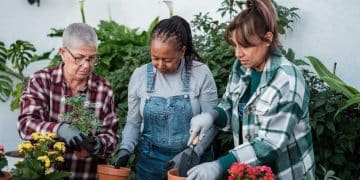Secure $10,000 Grants for Community Projects in 2025: A Guide

Securing a $10,000 grant for community action projects in 2025 primarily involves meticulous planning, identifying suitable funders, crafting compelling proposals, and demonstrating clear community impact and sustainability.
For many community action initiatives, the pursuit of financial support often feels like navigating a complex maze. The question of How Can Community Action Projects Secure $10,000 Grants in 2025? is more pertinent than ever, as organizations seek to maximize their impact with accessible funding. This guide aims to demystify the grant application process, offering actionable insights and strategic approaches for securing vital resources to fuel community-driven change.
Understanding the Funding Landscape for Community Action
The landscape of grant funding is dynamic, with trends and priorities shifting annually. In 2025, community action projects must align their proposals with current societal needs and philanthropic interests. Understanding who funds what, and why, is the cornerstone of a successful grant acquisition strategy.
Grantmakers, ranging from federal agencies and large foundations to corporate social responsibility programs and local charities, often have specific focus areas. These can include environmental sustainability, youth empowerment, public health, economic development, or social justice. Identifying funders whose missions resonate with your project’s goals is crucial for increasing your chances of success.
Types of Grant Funders
Diving into the different types of funders can refine your search and tailor your approach effectively. Each category has its own nuances, application processes, and preferred project types.
- 🏛️ Government Grants: Often large-scale but highly competitive, requiring extensive compliance and detailed reporting.
- 🤝 Private Foundations: Vary widely in size and focus, from large national entities to smaller family foundations.
- 🏢 Corporate Sponsorships: Businesses looking to enhance their public image through community investment.
- 🌟 Community Foundations: Focus on local needs, often distributing funds raised within a specific geographic area.
Beyond these primary sources, consider exploring individual donors, crowdfunding platforms, and even in-kind donations. A diversified funding strategy provides greater resilience and opportunities for growth. Remaining informed about their cycles and typical grant sizes ensures you target appropriate opportunities.
The key to navigating this landscape is thorough research. Utilize online databases like Foundation Directory Online, Grants.gov, and local community foundation websites. Look for grantors who have previously funded similar projects or organizations in your area. Review their past grantees, annual reports, and specific program guidelines to gauge their interests and funding patterns for 2025.
A deep understanding of the funding landscape allows community action projects to strategically position themselves for various opportunities, whether they are seeking a modest $10,000 grant or larger sums for expansive initiatives. This foundational knowledge empowers organizations to allocate their resources efficiently in the grant-seeking process.
Crafting a Compelling Project Narrative and Proposal
Once potential funders are identified, the next critical step is to articulate your project’s value through a compelling narrative and a well-structured proposal. A $10,000 grant, while not a massive sum, still requires a clear, concise, and persuasive argument detailing why your project deserves funding.
Your project narrative should tell a story: what problem are you addressing, who benefits, how will you achieve your goals, and what impact will your work have? This narrative should highlight the urgency and relevance of your project to the community you serve, demonstrating a deep understanding of local needs and challenges.
Key Elements of a Strong Proposal
A strong grant proposal typically includes several core components, each serving a specific purpose in building a convincing case for support.
- 🎯 Executive Summary: A concise overview of the entire proposal, serving as your project’s elevator pitch.
- 🔍 Problem Statement: Clearly define the issue your project addresses, supported by data or testimonials.
- 💡 Project Description: Outline your goals, objectives, activities, and expected outcomes in detail.
- 👥 Organizational Capacity: Demonstrate your team’s expertise, experience, and ability to execute the project successfully.
The budget section needs to be realistic and clearly itemized, showing how the $10,000 will be used to achieve the stated objectives. Transparency in financial planning builds trust with potential funders. Additionally, a robust evaluation plan that outlines how you will measure success and track progress is essential. Funders want to see that their investment will lead to tangible, measurable results.
Avoid jargon and overly technical language. Write in a clear, accessible style that can be understood by both experts and non-experts. Emphasize the long-term impact and sustainability of your project beyond the grant period. Funders are increasingly interested in initiatives that create lasting change and foster self-sufficiency within communities.

Seek feedback from peers, mentors, or grant writing professionals before submission. A fresh pair of eyes can catch errors, identify areas for improvement, and ensure that your message is clear and impactful. This iterative process of drafting and refining is invaluable for maximizing your proposal’s chances of success.
Ultimately, a compelling project narrative and a meticulously crafted proposal are your primary tools for securing a $10,000 grant. They provide funders with the necessary information to make an informed decision, showcasing your project’s merit and potential for significant community impact.
Demonstrating Community Impact and Sustainability
Beyond a well-written proposal, grantors are increasingly focused on the measurable impact and long-term sustainability of community action projects. Securing a $10,000 grant in 2025 hinges on effectively communicating how your project will create tangible benefits and continue its work beyond the grant period.
Impact is not just about the number of people served; it’s about the quality of change. Quantify your expected outcomes whenever possible. For example, instead of saying “we will help many children,” specify “we will improve literacy rates for 50 at-risk children by 20% within six months.” Use data, testimonials, and compelling stories to illustrate the need and the potential positive change your project will bring.
Building a Case for Lasting Change
Funders want to know their investment will yield sustainable results. Consider how your project will continue to generate value long after the initial grant funds are expended.
- 📈 Measurable Outcomes: Define specific, measurable, achievable, relevant, and time-bound (SMART) goals.
- 🌱 Long-term Vision: Outline how your project could grow, scale, or become self-sustaining over time.
- 🤝 Community Involvement: Emphasize how the community itself is invested in and contributing to the project’s success.
- 💰 Diversified Funding: Show you are exploring multiple funding streams beyond this single grant.
Demonstrating community engagement is vital. Show that your project is not just for the community, but built with it. Highlight partnerships with local organizations, volunteer involvement, and how community members themselves helped identify the need and shape the solution. This collaborative approach indicates strong roots and greater potential for long-term impact.
Sustainability can also involve developing revenue streams, training local leaders to take over, or building systems that continue to function independently. Even for a $10,000 grant, demonstrating a vision for continuity signifies good stewardship of funds and a commitment to lasting change. Outline a clear plan for evaluating success.
The ability to succinctly and powerfully convey your project’s impact and its path to sustainability will significantly elevate your grant application, positioning your community action initiative as a wise investment for any grantor in 2025. It moves your proposal from a mere request for funds to a compelling case for creating enduring good.
Strategic Networking and Partnership Building
In the competitive world of grant funding, it’s not just what you know, but who you know, especially how those connections can bolster your project. Strategic networking and forming robust partnerships are often underestimated but powerful tools for community action projects seeking $10,000 grants in 2025.
Networking extends beyond simply attending events; it involves building genuine relationships with individuals and organizations that share common goals. Funders are more likely to support projects with a strong foundation of community support and collaboration, as this indicates broader impact and increased likelihood of success. Building a strong network introduces your project to potential allies and advocates.
Maximizing Your Network and Collaborations
Effective networking and partnership building involve several proactive steps that can open doors to funding opportunities and resources.
- 🌐 Attend Industry Events: Participate in local and national conferences, workshops, and seminars related to community development.
- 🤝 Connect with Peer Organizations: Learn from others, share best practices, and identify potential areas for collaboration.
- 🏛️ Engage with Local Government and Leadership: Build relationships with city officials, council members, and community leaders.
- 🗣️ Seek Introductions: Leverage your existing network to gain introductions to potential funders or influential individuals.
Partnerships can take many forms: formal collaborations, collective impact initiatives, or informal agreements to share resources and expertise. A strong partnership demonstrates that your project has broader support and can leverage additional resources beyond the grant itself, making your $10,000 request appear more impactful.
When approaching potential partners, clearly articulate the mutual benefits of the collaboration. What can your project offer them, and how will their involvement strengthen your initiative? This reciprocal approach fosters more sustainable and equitable partnerships. A partnership with a well-established entity can also lend credibility to a newer organization or project, enhancing its appeal to funders.
Strategic networking and partnership building are dynamic processes that require consistent effort and clear communication. These connections can provide invaluable insights into funding opportunities, offer letters of support for your grant applications, and even lead to direct financial contributions. They are an investment in your project’s future viability.
The Importance of Data, Evaluation, and Reporting
In the current grant-making environment, data-driven decision-making is paramount. For community action projects, securing a $10,000 grant in 2025 increasingly relies on the ability to collect, analyze, and present compelling data that demonstrates both the need for the project and its achieved impact. This focus on tangibles extends through rigorous evaluation and transparent reporting.
Before even applying, gather baseline data that clearly illustrates the problem your project aims to solve. This could include demographic information, statistics on existing issues, or survey results from your target community. Quantifiable evidence strengthens your problem statement and establishes a clear benchmark against which to measure future success.
Building a Robust Measurement Framework
A clear plan for data collection, evaluation, and reporting instills confidence in funders and showcases your capacity for accountability.
- 📊 Baseline Data: Establish clear metrics before project initiation to track progress effectively.
- 📈 Process Evaluation: Monitor project activities to ensure they are being implemented as planned.
- 📏 Outcome Evaluation: Measure the short-term and long-term impacts of your project on the community.
- ✍️ Regular Reporting: Provide consistent, clear updates on progress, challenges, and successes.
For a $10,000 grant, while extensive research might be overkill, having a logical and straightforward plan for measuring outcomes is crucial. How will you know if your project is successful? What indicators will you track? Even simple surveys, attendance records, or pre- and post-intervention assessments can provide valuable data. Clearly stating how these metrics align with objectives is important.
Funders are not only interested in what you plan to do, but also what you have done and what you are doing. Transparent and timely reporting builds trust and enhances your reputation as a responsible steward of funds. Be prepared to provide regular updates, financial statements, and progress reports as required by the grant agreement. Funders appreciate concise, clear, and honest reporting.

Even if a project is small, strong reporting practices can open doors to future funding, including larger grants. It demonstrates professionalism and a commitment to accountability. This continuous cycle of planning, implementing, evaluating, and reporting creates a virtuous loop of improvement and increased funding success.
In essence, integrating robust data collection, a thoughtful evaluation plan, and meticulous reporting practices into your project from the outset significantly enhances its appeal to grantors. It transforms your request from an aspirational plea into a credible, measurable investment for community betterment.
Avoiding Common Pitfalls and Strengthening Your Application
Even with a strong project and compelling narrative, numerous pitfalls can derail a grant application for community action projects seeking $10,000 in 2025. Recognizing and actively avoiding these common mistakes can significantly strengthen your chances of success.
One prevalent pitfall is failing to thoroughly read and adhere to the grantor’s specific guidelines. Every funder has unique requirements, from page limits and formatting to specific budget categories and desired outcomes. Disregarding these instructions, however minor, immediately signals a lack of attention to detail and professionalism, risking immediate rejection.
Strategies to Bolster Your Application
Strengthening your application involves a combination of meticulous review, strategic positioning, and understanding the funder’s perspective.
- 📖 Read Guidelines Carefully: Double-check all instructions and adhere to them precisely, including word counts and formatting.
- 🎯 Align with Funder’s Mission: Clearly articulate how your project directly supports the grantor’s stated priorities and values.
- ❌ Avoid Jargon: Use clear, straightforward language accessible to a broad audience, including those unfamiliar with your specific field.
- 🔄 Proofread Meticulously: Errors in grammar, spelling, or punctuation can undermine your credibility. Get multiple eyes on the draft.
Another common mistake is submitting a generic proposal. Funders receive countless applications, and those that clearly demonstrate a tailored understanding of their specific interests stand out. Customize your language, examples, and proposed outcomes to directly address what the particular grantor values. A “one-size-fits-all” approach rarely succeeds.
Underestimating the importance of demonstrating your organization’s capacity is also a frequent oversight. Even if your project is innovative, funders want assurance that you have the internal skills, experience, and infrastructure to execute it effectively. Highlight your team’s expertise, past successes, and strong financial management practices. This part of the proposal is about building trust.
Finally, neglecting to follow up appropriately can be a missed opportunity. While persistent badgering is discouraged, a polite inquiry about the application status after the stated review period, or a brief thank-you note, can reinforce your interest and professionalism. This thoughtful follow-up shows genuine enthusiasm and commitment.
By diligently avoiding common pitfalls and proactively adopting strategies to strengthen your application, community action projects can significantly increase their likelihood of securing a $10,000 grant in 2025. It’s about presenting your project not just as a need, but as a compelling, well-executed solution ready for investment.
| Key Point | Brief Description |
|---|---|
| 📊 Project Pitch | A clear, concise, and compelling narrative of your project’s purpose and impact. |
| 🔍 Funder Research | Identify grantors whose mission aligns directly with your community action goals. |
| 💪 Capacity & Impact | Showcase your team’s capability and the measurable, sustainable benefits for the community. |
| 🤝 Networking | Build strong relationships and partnerships to strengthen your application and credibility. |
Frequently Asked Questions About Community Grants
The timeline varies significantly depending on the grantor. Some smaller, local foundations might have a two to three-month turnaround from application to award, while larger foundations or government agencies could take six months to a year. Always check the specific funder’s stated timeline in their guidelines to manage expectations.
Most traditional grantors require applicants to be a registered 501(c)(3) nonprofit or to have a fiscal sponsor with 501(c)(3) status. However, some foundations and corporate giving programs may support grassroots initiatives or projects led by fiscally sponsored groups. Always verify the eligibility criteria of each grant opportunity.
It depends on the specific grant. Some grants are restricted to project-specific expenses, while others may allow a portion for general operating support, covering costs like salaries, rent, or utilities. Clearly define your budget needs and ensure they align with the grant’s allowable expenses. Transparency is key when detailing these expenditures.
A fiscal sponsor is a 501(c)(3) nonprofit organization that agrees to manage the financial and administrative aspects of your project. This allows your project to receive grants from funders who only give to 501(c)(3)s, even if you are not one yourself. They provide legal and financial oversight, but often charge a percentage fee for their services.
Grant rejections are common. Use them as learning opportunities. Politely request feedback from the grantor, if they offer it, to understand areas for improvement. Analyze your proposal for weaknesses, refine your approach, and continue applying to other relevant opportunities. Persistence is crucial in the grant-seeking process.
Conclusion
Securing a $10,000 grant for community action projects in 2025 is an achievable goal, contingent on a strategic, well-executed approach. It requires a meticulous understanding of the funding landscape, the ability to craft compelling narratives, a strong demonstration of community impact and sustainability, vigorous networking, and a commitment to data-driven evaluation. By diligently addressing each of these facets, community organizations can significantly enhance their prospects, turning ambitious visions into tangible community improvements. The journey to funding is often challenging, but with preparation and perseverance, vital resources can be unlocked to foster meaningful, lasting change.





